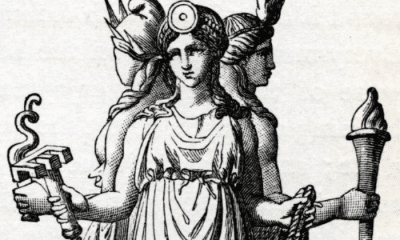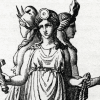Greek
Odin and Zeus
Were the kings of the Greek and Norse pantheons very much alike, or did they have more in common with other gods?
Odin and Zeus were both kings of their pantheons, Odin in Northern Europe and Zeus in Greece. But how deep were their similarities?
Images of the two gods seem remarkably similar. Both were shown as wise, bearded men who exercised paternal authority in their realms.
There are noticeable differences, however. Odin is often dressed more simply than regally and lacks Zeus’s iconic thunderbolts.
While Zeus was a master of the sky, Odin walked the line between the realms of the living and the dead. While he hurled thunder down from Olympus, Odin walked among men in search of hidden knowledge.
There was a Norse god who used his powerful frame to throw lightning at his enemies, however. In Norse mythology, Odin’s son is even more similar to the Olympian king than Odin himself.
The Greek Zeus and the Norse Odin
At a glance, Odin and Thor seem to be remarkably similar.
Both were the kings of their respective pantheons. They were similarly pictured with the trappings of wisdom and authority – a long gray beard and authoritative build.
Zeus and Odin were also looked at as father figures in mythology.
Zeus was the literal father of many gods and heroes and also acted in a paternal role to those Olympians who did not have parents. One of Odin’s epithets, meanwhile, was the All-Father.
They were not only the fathers of individual gods and heroes, but also of nations. Just as Zeus was the ancestor of many of Greece’s founding kings, Odin was believed to have been the forefather of many of the Germanic peoples.
The two gods also have remarkably similar origin stories. Both Zeus and Odin worked with their two brothers to defeat the previous ruling powers of the gods, the Titans in Greece and the Giants of Scandinavia.
Beyond their bearded faces and positions of power, however, the differences between Zeus and Odin become more apparent.
Zeus was the god of thunder and storms, whose anger was made known in flashes of lightning. While Odin was a warrior, he was most known as the god of wisdom.
Stories of Odin were often less concerned with his role as a powerful leader and took on elements more fitting for a folk hero than the king of the gods. He had many adventures traveling the world, usually in disguise, in his search for knowledge and truth.
While Zeus most often visited earth in pursuit of a mistress, the Norse believed that Odin often appeared among humans in the form of a simple traveler. While a few myths exist of Zeus enforcing the laws of hospitality in person, such stories are almost central to the character of Odin.
Zeus’s domain was inherently linked to the sky, but Odin often took on more associations with death and mysticism. As the god of wisdom he had even died as a sacrifice in his own name to discover the greatest hidden knowledge of the world.
The warriors of the Norse culture believed that they would go to Odin’s hall, Valhalla, after their death. Odin was a ruler of the afterlife as much as one of the gods, while Zeus’s brother Hades received the dead in Greece.
When the Germanic people of Northern Europe interacted with the people of Rome, their chief god was not identified with Zeus/Jupiter at all. The Romans claimed that Mercury, Greek Hermes, was the god most widely worshiped in the north.
Odin was identified with Mercury as a traveler who roamed the roads of the earth and guided the dead on the road to the underworld. If Odin was associated with the messenger god, though, which Norse god did the people of Greece and Rome think was most like Zeus?
My Modern Interpretation
While Zeus had some things in common with Odin, there were also key differences. When Greco-Roman people looked for an equivalent to their own king of the gods in the north, they instead saw similarities with Odin’s son.
Thor was the Norse god of storms, and his thunderbolts immediately reminded the Romans of Zeus/Jupiter.
Thor was also more immediately visible as a symbol of strength and power. Like Zeus he was shown as muscular and armed, while Odin was often in the guise of a poor traveler.
The iconic hammer of Thor also drew comparisons to Zeus’s son, Hercules. The Norse god’s weapon was as symbolic of his might as the club of Zeus’s famous offspring.
Yet, Thor was not the king of the gods. While widely revered and powerful, he was subservient to Odin.
Thor’s role was a much more tangible one, making his might known through thunder and storms in much the same way as Zeus. This was in contrast to Odin, who was associated with magic and invisible influences on the world.
It would seem, then, that the Norse people had two gods that were cognates of the Greek Zeus. One took on his rulership and wisdom, while the other showed similar physical prowess and a connection to storms.
In fact, all three gods probably share a similar origin.
Both the Greeks and the Norse were preceded by earlier cultures, who in the far distant past had shared roots. Gods of similar types could be found across Europe and Asia because they shared an origin in early Indo-European religions.
Most of these religions shared certain archetypes, including both a godly father/king and a god of the sky and storms.
Often, these two types were embodied in the same character. The Slavic Perun, Hindu Indra, Vedic Dyaus, and Finnish Ukko were all of this type.
Sometimes, however, shifts in culture over time lead to the archetype being represented by two separate deities. This was the case with Odin and Thor.
It is impossible to say which god came first in the pre-Germanic religion. While Odin’s name does not seem to have any non-Germanic influence, his position as the older of the two gods could point to an earlier origin.
Zeus thus had parallels to both Odin and Thor in the ancient archetypes of the king of the gods and the god of thunder. While Thor’s thunderbolts were an obvious link between the two, Odin’s wisdom and status also made him of a similar type to Zeus.
In Summary
Zeus and Odin share many similarities as paternalistic kings of their respective pantheons, but a direct link between the two is not strong. The Romans themselves did not equate the Germanic gods’ king with their own.
Instead, both the Romans and modern historians see more similarities between Thor and Zeus. While Thor was Odin’s son, he shared Zeus’s role as a powerful sky god.
Neither Norse god is a complete cognate of the Greco-Roman sky lord, however. While the three share their roots in prehistoric Indo-European culture, the Norse gods were influenced in different ways.
The roles of king and sky god were split in the Norse pantheon, giving some powers to Odin and some to Thor. Together, the two gods shared much in common with Zeus but on their own neither is a complete match.



